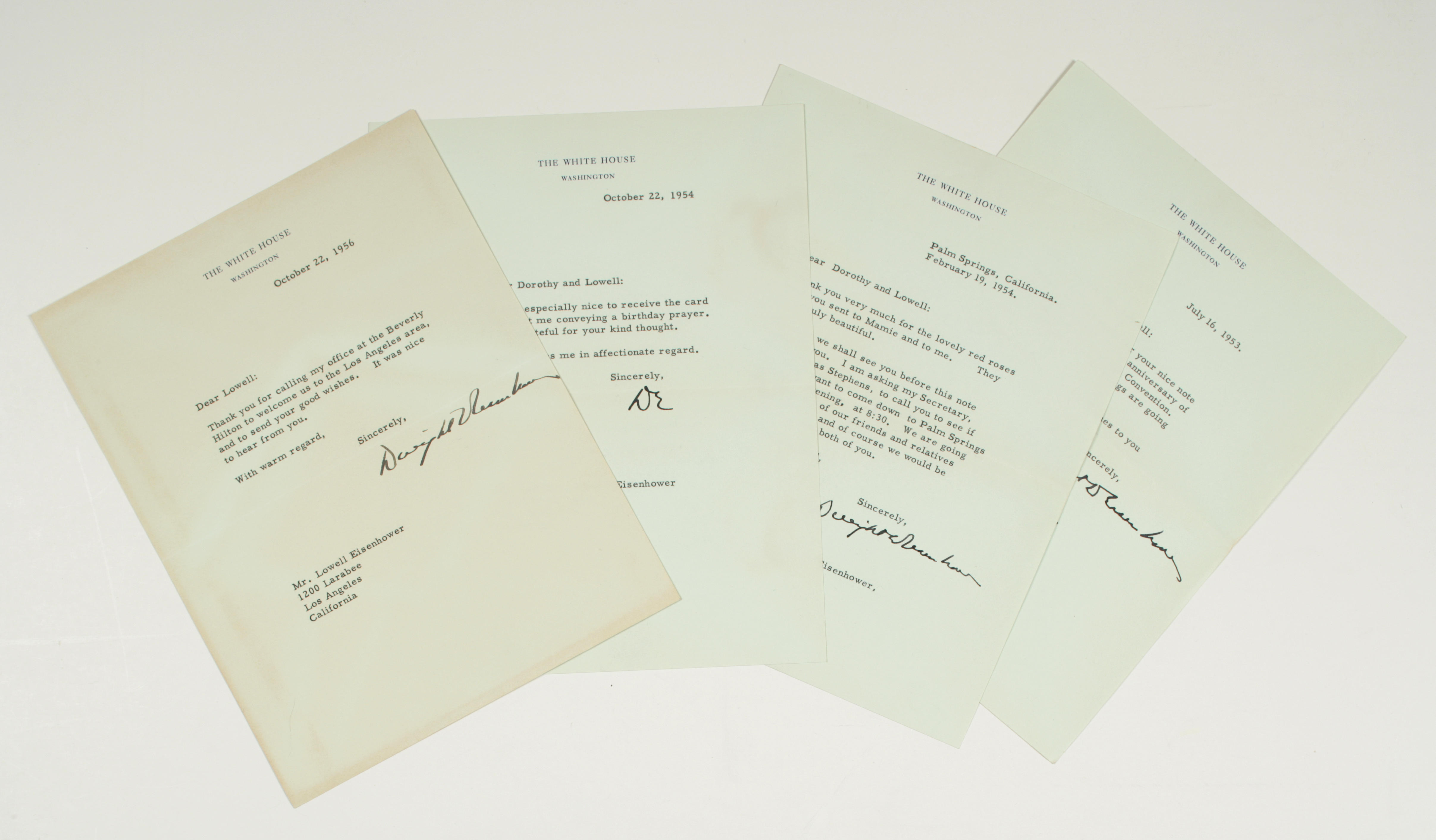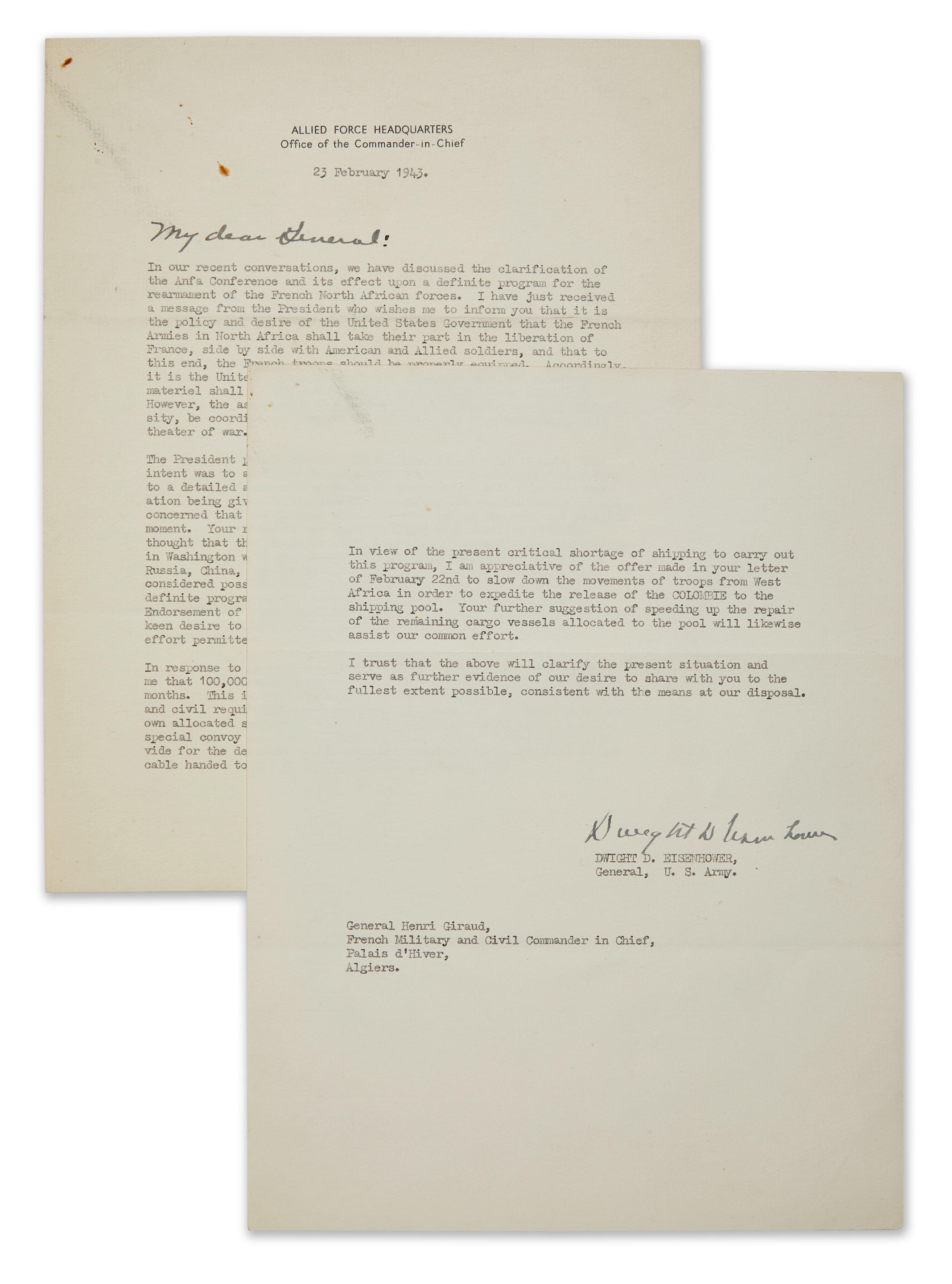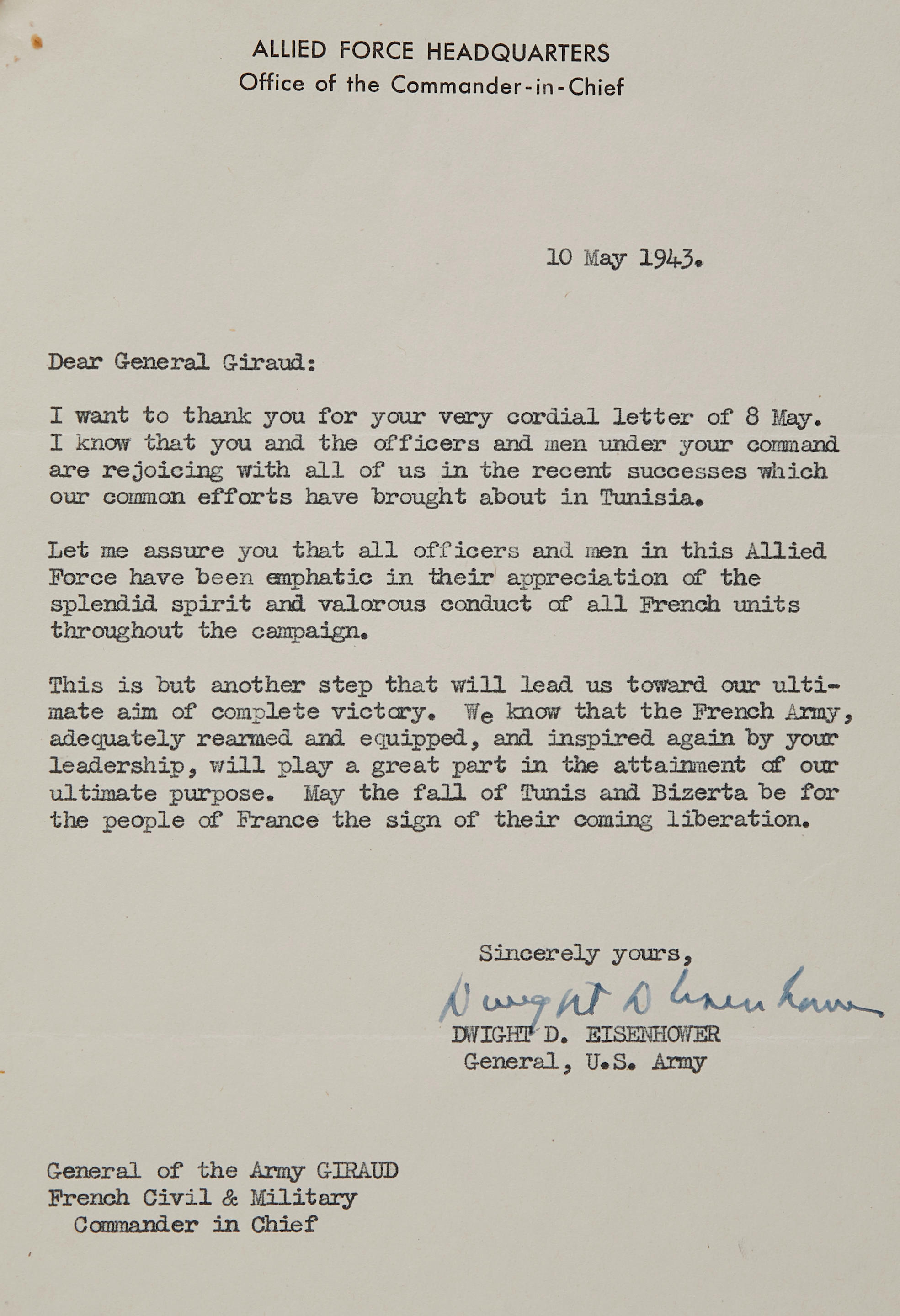EISENHOWER, Dwight David. Typed document signed ("Dwight D Eisenhower") as Supreme Allied Commander, comprising copy No.16 of his cable FWD-20798 (SCAF 355) to the Allied Combined Chiefs of Staff and British Chiefs of Staff, SHAEF (Supreme Headquarters Allied Expeditionary Force), Forward [Headquarters, Rheims, France], 7 May 1945. 1 page, 4to (10 x 7.78 in.), typed on stationery bearing the heading "TOP SECRET SHAEF FORWARD...OUTGOING MESSAGE heading printed in red, ink-stamped copy number "16" at bottom right, signed in ink by Eisenhower in the central portion, penciled notations in very pale red ink-stamped compartments (dispatch records?) in blank area, verso with red ink "received 7 May 1945" stamp, very slight browning. THE END OF THE GREAT CRUSADE: "THE MISSION OF THIS ALLIED FORCE WAS FULFILLED...": EISENHOWER ANNOUNCES THE END OF THE WAR IN EUROPE A TYPED ORIGINAL--NOT A RIBBON COPY OR A MIMEOGRAPHED COPY--of the most momentous wartime message from Eisenhower's pen, officially announcing the end of World War II in Europe. The collapse of the German war-machine, once it had begun, progressed swiftly: Allied armies crossed the Rhine at Remagen on March 7; on 25 April elements of the U.S. First Army encountered units of the Russian 5th Army at Torgau on the Elbe, and the same day two Russian armies under Zhukov and Konev completed the encirclement of Berlin. On April 30, with Soviet troops closing in on his bunker, Hitler named Admiral Karl Doenitz his successor, then took his own life. The Berlin garrison surrendered unconditionally on May 2. General Walter Bedell Smith (1824-1903), Eisenhower's Chief of Staff, had previously signed, on Eisenhower's behalf, the surrender of the German armies in Italy (April 28). On the morning of May 7, in a former schoolhouse at Rheims, he played a similar historic role, accepting on behalf of the United States the final, unconditional German surrender. The Supreme Commander himself did not attend the signing, but met briefly with Field Marshall Alfred Jodl (1892-1946), head of the German delegation, to warn him that he would be held "personally and officially responsible for any violations of the surrender." Once the Act of Military Surrender had been signed by Smith, Jodl and representatives of France and the Soviet Union, Smith suggested to his commander that the momentous news should be communicated to the Combined Chiefs of Staff. Smith and many of his colleagues at SHAEF attempted to compose the historic message. "I tried one myself," Smith recalled, "and like all my associates, groped for resounding phrases as fitting accolades to the Great Crusade and indicative of our dedication to the great task just completed" ( Eisenhower's Six Great Decisions , p.229). But Eisenhower considered and rejected a stack of draft messages proposed by his staff, all of whom were "looking for a rhetorical flourish, something sure to make it into the history books" (Geoffrey Perret, Eisenhower , 1999 p.348). Finally, early in the morning, the Supreme Commander himself composed the present message--"almost Roman in its directness and vigor" (Perret), reading simply: "The mission of this Allied Force was fulfilled at 0241, local time, May 7th, 1945." THE FORBES EXAMPLE IS THE ONLY RECORDED TYPESCRIPT ORIGINAL. It is not clear how many copies of the telegram exist, and manifestly only a small number were signed by Eisenhower to commemorate the historic event, but since World War II a total of six examples, including the present, have been sold at auction. Of those six, only the present is a typescript original, the others--all evidently reproduced from typescript by mimeograph on SHAEF stationery--differ in minor but telling typographical details and are printed in a typical purple mimeograph ink, with the text of Eisenhower's message in a thin red ink. The present copy, in black typewriter ink, is, an original top copy and was so described by Charles Hamilton when offered by him in 1980. The mim
EISENHOWER, Dwight David. Typed document signed ("Dwight D Eisenhower") as Supreme Allied Commander, comprising copy No.16 of his cable FWD-20798 (SCAF 355) to the Allied Combined Chiefs of Staff and British Chiefs of Staff, SHAEF (Supreme Headquarters Allied Expeditionary Force), Forward [Headquarters, Rheims, France], 7 May 1945. 1 page, 4to (10 x 7.78 in.), typed on stationery bearing the heading "TOP SECRET SHAEF FORWARD...OUTGOING MESSAGE heading printed in red, ink-stamped copy number "16" at bottom right, signed in ink by Eisenhower in the central portion, penciled notations in very pale red ink-stamped compartments (dispatch records?) in blank area, verso with red ink "received 7 May 1945" stamp, very slight browning. THE END OF THE GREAT CRUSADE: "THE MISSION OF THIS ALLIED FORCE WAS FULFILLED...": EISENHOWER ANNOUNCES THE END OF THE WAR IN EUROPE A TYPED ORIGINAL--NOT A RIBBON COPY OR A MIMEOGRAPHED COPY--of the most momentous wartime message from Eisenhower's pen, officially announcing the end of World War II in Europe. The collapse of the German war-machine, once it had begun, progressed swiftly: Allied armies crossed the Rhine at Remagen on March 7; on 25 April elements of the U.S. First Army encountered units of the Russian 5th Army at Torgau on the Elbe, and the same day two Russian armies under Zhukov and Konev completed the encirclement of Berlin. On April 30, with Soviet troops closing in on his bunker, Hitler named Admiral Karl Doenitz his successor, then took his own life. The Berlin garrison surrendered unconditionally on May 2. General Walter Bedell Smith (1824-1903), Eisenhower's Chief of Staff, had previously signed, on Eisenhower's behalf, the surrender of the German armies in Italy (April 28). On the morning of May 7, in a former schoolhouse at Rheims, he played a similar historic role, accepting on behalf of the United States the final, unconditional German surrender. The Supreme Commander himself did not attend the signing, but met briefly with Field Marshall Alfred Jodl (1892-1946), head of the German delegation, to warn him that he would be held "personally and officially responsible for any violations of the surrender." Once the Act of Military Surrender had been signed by Smith, Jodl and representatives of France and the Soviet Union, Smith suggested to his commander that the momentous news should be communicated to the Combined Chiefs of Staff. Smith and many of his colleagues at SHAEF attempted to compose the historic message. "I tried one myself," Smith recalled, "and like all my associates, groped for resounding phrases as fitting accolades to the Great Crusade and indicative of our dedication to the great task just completed" ( Eisenhower's Six Great Decisions , p.229). But Eisenhower considered and rejected a stack of draft messages proposed by his staff, all of whom were "looking for a rhetorical flourish, something sure to make it into the history books" (Geoffrey Perret, Eisenhower , 1999 p.348). Finally, early in the morning, the Supreme Commander himself composed the present message--"almost Roman in its directness and vigor" (Perret), reading simply: "The mission of this Allied Force was fulfilled at 0241, local time, May 7th, 1945." THE FORBES EXAMPLE IS THE ONLY RECORDED TYPESCRIPT ORIGINAL. It is not clear how many copies of the telegram exist, and manifestly only a small number were signed by Eisenhower to commemorate the historic event, but since World War II a total of six examples, including the present, have been sold at auction. Of those six, only the present is a typescript original, the others--all evidently reproduced from typescript by mimeograph on SHAEF stationery--differ in minor but telling typographical details and are printed in a typical purple mimeograph ink, with the text of Eisenhower's message in a thin red ink. The present copy, in black typewriter ink, is, an original top copy and was so described by Charles Hamilton when offered by him in 1980. The mim













Try LotSearch and its premium features for 7 days - without any costs!
Be notified automatically about new items in upcoming auctions.
Create an alert